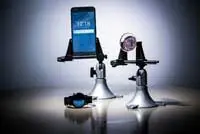 Researchers from University of Washington (UW) have developed a way for devices as varied as brain implants, contact lenses and credit cards, to communicate with mobile devices. In one demonstration, a smartwatch transmitted a Bluetooth signal to a smart contact lens fitted with an antenna.
Researchers from University of Washington (UW) have developed a way for devices as varied as brain implants, contact lenses and credit cards, to communicate with mobile devices. In one demonstration, a smartwatch transmitted a Bluetooth signal to a smart contact lens fitted with an antenna.
The team's process relies on a communication technique called backscatter, which allows devices to exchange information by reflecting existing signals. Because the technique enables Bluetooth signals to be converted into Wi-Fi transmissions, the team calls it ‘interscattering.’
"Instead of generating Wi-Fi signals on your own, our technology creates Wi-Fi by using Bluetooth transmissions from nearby mobile devices such as smartwatches," said research associate Vamsi Talla.
Interscatter communication uses the Bluetooth, Wi-Fi or ZigBee radios embedded in common mobile devices to serve as both sources and receivers for these reflected signals, potentially using 10,000 times less energy than conventional methods.
The UW team has developed an innovative way to transform Bluetooth transmissions into a ‘single tone’ signal that can be further manipulated and transformed. By backscattering that single tone signal, a contact lens could encode data -- such as health information it may be collecting -- into a standard Wi-Fi packet that could then be read by a smartphone, tablet or laptop.
"Bluetooth devices randomise data transmissions using a process called scrambling," said assistant professor Shyam Gollakota. "We figured out a way to reverse engineer this scrambling process to send out a single tone signal from Bluetooth-enabled devices such as smartphones and watches using a software app."
The challenge is that backscattering creates an unwanted mirror image copy of the signal, which consumes more bandwidth, and interferes with networks on the mirror copy Wi-Fi channel. However, the UW team developed a technique called ‘single sideband backscatter’ to eliminate the unintended by-product and freeing bandwidth.
Pic: Credit: Mark Stone/University of Washington
Author
Peggy Lee
Source: www.newelectronics.co.uk

